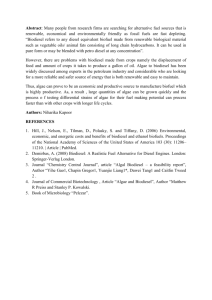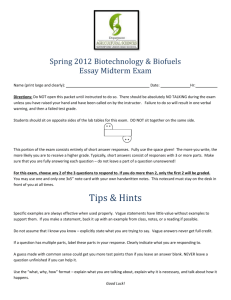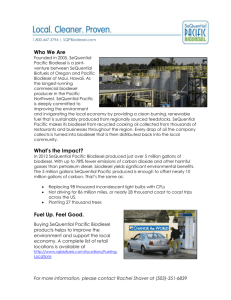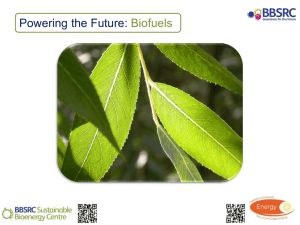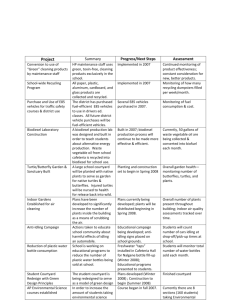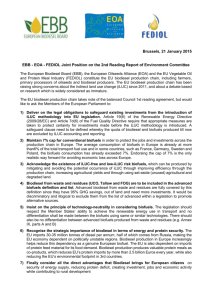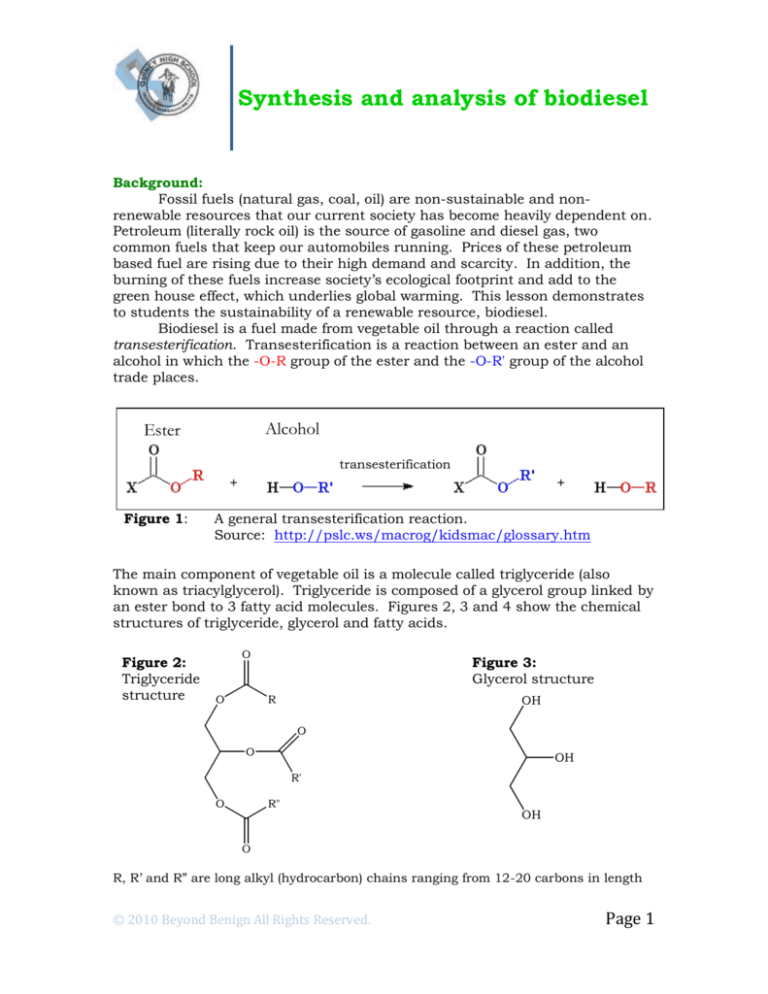
Synthesis and analysis of biodiesel
Background:
Fossil fuels (natural gas, coal, oil) are non-sustainable and nonrenewable resources that our current society has become heavily dependent on.
Petroleum (literally rock oil) is the source of gasoline and diesel gas, two
common fuels that keep our automobiles running. Prices of these petroleum
based fuel are rising due to their high demand and scarcity. In addition, the
burning of these fuels increase society’s ecological footprint and add to the
green house effect, which underlies global warming. This lesson demonstrates
to students the sustainability of a renewable resource, biodiesel.
Biodiesel is a fuel made from vegetable oil through a reaction called
transesterification. Transesterification is a reaction between an ester and an
alcohol in which the -O-R group of the ester and the -O-R' group of the alcohol
trade places.
Alcohol
Ester
transesterification
Figure 1:
A general transesterification reaction.
Source: http://pslc.ws/macrog/kidsmac/glossary.htm
The main component of vegetable oil is a molecule called triglyceride (also
known as triacylglycerol). Triglyceride is composed of a glycerol group linked by
an ester bond to 3 fatty acid molecules. Figures 2, 3 and 4 show the chemical
structures of triglyceride, glycerol and fatty acids.
Figure 2:
Triglyceride
structure
O
O
Figure 3:
Glycerol structure
R
OH
O
O
OH
R'
O
R"
OH
O
R, R’ and R” are long alkyl (hydrocarbon) chains ranging from 12-20 carbons in length
© 2010 Beyond Benign All Rights Reserved.
Page 1
Synthesis and analysis of biodiesel
O
Figure 4:
Fatty acid structures. Fatty acids
contain a polar carboxylic acid
group (-COOH) and a nonpolar
alkyl group (-R, -R’, -R”). The
conversion of a polar carboxylic
acid to a nonpolar methyl or ethyl
ester converts the properties the of
fatty acids to be similar to fossil
fuel diesel.
HO
O
R
HO
R'
O
HO
R"
The ester group in triglyceride will exchange places with the alcohol
group in methanol or ethanol* to form biodiesel. Biodiesel is a methyl or ethyl
ester (depending on whether methanol or ethanol is used) of a long chain fatty
acid hydrolyzed from triglyceride.
O
O
O
O
+
O
R'
O
+
OH
R
3 CH3CH2OH
H3CH2CO
R
O
NaOH
OH
Ethanol
+
H3CH2CO
R'
OH
R"
O
Glycerol
O
+
H3CH2CO
R"
Triglyceride
3 ethyl esters
of fatty acids
Figure 5:
BIODIESEL
The transesterification reaction in the synthesis of biodiesel
The chemical composition of diesel is about 75% saturated hydrocarbons
(primarily paraffins including n, iso, and cycloparaffins), and 25% aromatic
hydrocarbons (including naphthalenes and alkylbenzenes). The average
chemical formula for common diesel fuel is C12H23, ranging from approx. C10H20
to C15H28. The heat of combustion of diesel = 10,700 cal/g.
© 2010 Beyond Benign All Rights Reserved.
Page 2
Synthesis and analysis of biodiesel
Goal:
The goal of this unit is for the students to understand that our current
practices of burning gasoline and diesel gas for automotive transportation is not
sustainable and has a big ecological footprint. Students will learn about a
renewable resource that may be able to replace gasoline and diesel fuel one day.
By synthesizing biodiesel, students will learn how it is made and where it comes
from. By analyzing biodiesel, students will be able to determine how likely
biodiesel is to eventually replace gasoline and diesel gas as our primary
transportation fuels.
Objectives:
Students will …
Determine the properties of various cooking oils
Synthesize biodiesel
Determine the properties of their biodiesel
Analyze biodiesel’s heat of combustion
Assess whether biodiesel can be used in transportation vehicles or not
Materials:
See the materials section for each lesson plan
Time Required:
Lesson 1:
Lesson 2:
Lesson 3:
Properties of various cooking oils
(1 x 45-60 minute class period)
Synthesis of biodiesel (1 x 90 minute class period)
Analysis of biodiesel (1 x 90 minute class period)
United States National Science Education Standards (NSES) Met:
MA State Science Standards Met (MA Department of Education Science
and Technology/Engineering Frameworks):
Properties of Matter
Broad Concept: Physical and chemical properties can be used to classify and
describe matter.
1.1
Identify and explain some of the physical properties that are used
to classify matter, e.g., density, melting point, and boiling point.*
1.2
Explain the difference between mixtures and pure substances.*
Chemical Bonding
Central Concept: Atoms bond with each other by transferring or sharing valence
electrons to form compounds.
4.5
Identify how hydrogen bonding in water affects a variety of physical,
chemical, and biological phenomena (e.g., surface tension, capillary
action, density, boiling point).
© 2010 Beyond Benign All Rights Reserved.
Page 3
Synthesis and analysis of biodiesel
5. Chemical Reactions and Stoichiometry
Central Concepts: In a chemical reaction, one or more reactants are
transformed into one or more new products. Chemical equations represent the
reaction and must be balanced. The conservation of atoms in a chemical
reaction leads to the ability to calculate the amount of products formed and
reactants used (stoichiometry).
5.1
Balance chemical equations by applying the laws of conservation of mass
and constant composition (definite proportions).
5.2
Classify chemical reactions as synthesis (combination), decomposition,
single displacement (replacement), double displacement, and combustion.
5.3
Use the mole concept to determine number of particles and molar mass
for elements and compounds.
5.5
Calculate the mass-to-mass stoichiometry for a chemical reaction.
5.6
Calculate percent yield in a chemical reaction.
6. States of Matter, Kinetic Molecular Theory, and Thermochemistry
Central Concepts: Gas particles move independently of each other and are far
apart. The behavior of gas particles can be modeled by the kinetic molecular
theory. In liquids and solids, unlike gases, particles are close to each other. The
driving forces of chemical reactions are energy and entropy. The reorganization
of atoms in chemical reactions results in the release or absorption of heat
energy.
6.4
Describe the law of conservation of energy. Explain the difference
between an endothermic process and an exothermic process.
Green principle met:
1. use of renewable feedstocks
2. use of safer chemicals
3. real-time monitoring
4. inherently safer chemistry for accident prevention
5. catalysis
Procedure:
PREP (if needed)
32 copies of the student sheets for lessons 1-3
Obtain materials needed prior to each lesson
IN CLASS
Supervise the students working
© 2010 Beyond Benign All Rights Reserved.
Page 4
Synthesis and analysis of biodiesel
Assessment:
Compare the students’ biodiesel’s heat of combustion versus literature
heat of combustion values of diesel
References:
http://www.doe.mass.edu/frameworks/current.html
Fisher Science Education; Beyond Benign. Think Green.
http://www.fishersci.com/ wps/ portal/
CMSTATIC?href=/ScienceEducation/ scienceEduStandard/ Features/
Think_Green/ se_std_ThinkGreen_040708_1435.jsp
&store=ScienceEducation &segment=scienceEduStandard (accessed
August 2008).
www.fisheredu.com
http://greenchem.uoregon.edu/gems.html
Thompson, J. E. Biodiesel Synthesis, Science Division, Lane Community
College, 2006
http://en.wikipedia.org/wiki/Diesel
http://en.wikipedia.org/wiki/Heat_of_combustion
Smith, J. G., Organic Chemistry, 2nd ed. McGraw-Hill
Science/Engineering/Math; February 23, 2007.
Freeman, W.H., Chemistry in the Community: (ChemCom),; 5th edition,
American Chemical Society (ACS), January 31, 2006.
© 2010 Beyond Benign All Rights Reserved.
Page 5
Synthesis and analysis of biodiesel
Student Sheet
Lesson 1: Properties of various cooking oils
This lesson contains 2 parts:
Part 1: Density of various cooking oils
Part 2: Freezing point and melting point of various cooking oils
Background:
Which vegetable oils are the best for use as biodiesel? What property do
you think a vegetable oil should have in order to operate properly in a diesel
engine? To think about this, we will first take a closer look at vegetable oils
that we find in the kitchen. Although these oils are similar to those used in
biodiesel, they cannot be used directly as fuel. These oils need to be chemically
converted to biodiesel fuel.
Objective:
Determine the density of various cooking oils
Determine the freezing point and melting point of various cooking oils
Part 1: Density of various oils
Materials:
Scale or triple beam balance
50 mL graduated cylinder
4 x various cooking oils (i.e. vegetable, canola, corn, peanut oils)
Procedure:
1. You will work in pairs.
2. Wear safety goggles, gloves and apron.
3. Weigh an empty 50 mL graduated cylinder. Record the mass in grams
(g).
4. Pour 20 mL of vegetable oil into the 50 mL graduated cylinder. Record
the exact volume of the vegetable oil in milliliters (mL).
5. Weigh the graduated cylinder and vegetable oil on a scale. Record the
mass in grams (g).
6. Repeat steps 3-5 for all of the various oils. Use clean glassware for each
oil.
7. Calculate the density of each oil by filling in the data sheet on the next
pages.
© 2010 Beyond Benign All Rights Reserved.
Page 6
Synthesis and analysis of biodiesel
Data for part 1 (density of various cooking oils):
Vegetable oil
1. Mass of an empty 50 mL graduated cylinder (in g)
___________________________________
2. Mass of a 50 mL graduated cylinder + 20 mL vegetable oil (in g)
___________________________________
3. Mass of 20 mL of vegetable oil (in g)
___________________________________
line 2 – line 1
4. Volume of 20 mL vegetable oil as determined from the graduated cylinder
(in mL)
___________________________________
5. Density (d) of the vegetable oil (g/mL)
___________________________________
(show calculations including units)
line 3 ÷ line 4
Canola oil
1. Mass of an empty 50 mL graduated cylinder (in g)
___________________________________
2. Mass of a 50 mL graduated cylinder + 20 mL canola oil (in g)
___________________________________
3. Mass of 20 mL of canola oil (in g)
___________________________________
line 2 – line 1
4. Volume of 20 mL canola oil as determined from the graduated cylinder
(in mL)
___________________________________
5. Density (d) of the canola oil (g/mL)
___________________________________
(show calculations including units)
© 2010 Beyond Benign All Rights Reserved.
line 3 ÷ line 4
Page 7
Synthesis and analysis of biodiesel
Corn oil
1. Mass of an empty 50 mL graduated cylinder (in g)
___________________________________
2. Mass of a 50 mL graduated cylinder + 20 mL corn oil (in g)
___________________________________
3. Mass of 20 mL of corn oil (in g)
___________________________________
line 2 – line 1
4. Volume of 20 mL corn oil as determined from the graduated cylinder
(in mL)
___________________________________
5. Density (d) of the corn oil (g/mL)
___________________________________
(show calculations including units)
line 3 ÷ line 4
Peanut oil
1. Mass of an empty 50 mL graduated cylinder (in g)
___________________________________
2. Mass of a 50 mL graduated cylinder + 20 mL peanut oil (in g)
___________________________________
3. Mass of 20 mL of peanut oil (in g)
___________________________________
line 2 – line 1
4. Volume of 20 mL peanut oil as determined from the graduated cylinder
(in mL)
___________________________________
5. Density (d) of the peanut oil (g/mL)
___________________________________
(show calculations including units)
© 2010 Beyond Benign All Rights Reserved.
line 3 ÷ line 4
Page 8
Synthesis and analysis of biodiesel
Part 2: Freezing point and melting point of various cooking oils
Materials:
4 x various types of oils (i.e. vegetable, canola, corn, peanut oils)
4 x graduated plastic transfer pipettes
2 x thermometers (wide-range)
1 x 500 mL beaker
1 x glass stirring rod
4 x test tubes (12 x 75 mm test tubes are a good size)
1 test tube rack
Rock salt
Ice
Dry ice (optional)
Water
Procedure:
1. Label a test tube with the name of the first oil.
2. Using the graduated plastic transfer pipette, transfer 2 mL of this oil into
the correspondingly labeled test tube.
3. Place a thermometer into the test tube.
4. Set the test tube in the test tube rack.
5. Add rock salt, ice and water to a 50 mL beaker. Stir the water with a
glass stirring rod to dissolve the salt.
6. Optional step: add dry ice instead of ice to the salt water mix after salt
has fully dissolved.
7. After the salt has dissolved (or after 5 minutes if dry ice was added in
step 5), record the temperature of the water in the beaker in degrees
Celsius (°C).
8. Transfer the test tube from the test tube rack into the beaker, making
sure not to get any water into the test tube.
9. Observe the oil in the test tube. Record the temperature on the
thermometer inside the test tube when the oil solidifies. This is the
freezing temperature of the oil.
10. Remove the test tube from the beaker and place it in the test tube rack.
11. Observe the oil in the test tube and record the temperature at which it
begins to liquify. This is the melting point of the oil.
12. Repeat steps 2-11 for each oil, using a new pipette and test tube for each
oil.
13. Fill in the data table on the next page.
© 2010 Beyond Benign All Rights Reserved.
Page 9
Synthesis and analysis of biodiesel
Data for part 2 (freezing point and melting point of various cooking oils):
Oil name
Freezing point (°C)
Melting point (°C)
Temperature of water, rock salt and ice:
˚C
If dry ice was used instead of ice,
Temperature of water, rock salt and dry ice:
˚C
Questions:
1. Which oil has the lowest freezing point?
TBD
2. Is the freezing point of the oils the same as the melting point of the oils?
Yes
3. What is the definition of freezing point? Of melting point?
The freezing point of a compound is the temperature at which the
compound converts from its liquid phase to its solid phase. The melting
point of a compound is the temperature at which the compound converts
from its solid phase to its liquid phase. The freezing point and melting
point of a substance is the same temperature.
4. What happens during the freezing/melting process in terms of molecular
dynamics?
During the freezing process, the molecules in the liquid slow down and
reduce their kinetic energy. The substance becomes more dense as the
molecules slow down, and eventually the substance converts from a
liquid form to a solid form. Alternatively during the melting process, the
molecules speed up in their motions, which may be due to an increase in
© 2010 Beyond Benign All Rights Reserved.
Page 10
Synthesis and analysis of biodiesel
temperature in the surrounding environment. Eventually, the solid
converts to a liquid during the melting process of a substance.
5. Besides density, freezing points and melting points, what other
properties might help you differentiate the oils?
Color, viscosity, odor, physical state at room temperature
6. If you are investigating the use of these oils for biodiesel engine, which oil
will you choose? Why?
Choose the oil with the lowest freezing point, so that it will freeze at lower
temperatures and can be used in more locations, including those that get
really cold in the winter.
7. What benefit do you think biodiesel has over the traditional diesel gas?
Biodiesel can be synthesized from vegetable oils, and can be done
without the use of fossil fuels. Traditional diesel gas is made using the
fossil fuels, which is a depleting resource. Because of this, traditional
diesel gas is not sustainable.
8. What are some examples of chemical change? How are they different
from a physical change?
Some examples of a chemical change include combining carbon dioxide
and water to make sugar (photosynthesis), mixing an acid with a base to
make a salt and water, and burning wood to create ashes. A chemical
change occurs when something new has been formed, or if something
has decomposed. A physical change does not require the formation of
something new or decomposition of a substance. Instead, a physical
change is one in which the state of matter changes. i.e. ice melts (solid
changes to liquid), dry ice subliming (solid changes to gas), boiling water,
or crumbling a post-it note.
© 2010 Beyond Benign All Rights Reserved.
Page 11
Synthesis and analysis of biodiesel
Further thinking:
1. What is the freezing point of water?
0˚C
2. What was the temperature of the water with rock salt and ice in it?
TBD
3. If dry ice was used, what was the temperature of the water with rock salt
and dry ice in it?
TBD
4. How low can the temperature of water and rock salt go before ice forms
(water solidifies)?
TBD
5. Explain why the freezing point of water is lowered with the addition of
rock salt.
The rock salt lowers the freezing point of water because its presence does
not allow water to create its pure crystalline lattice structure. By
incorporating itself within the water crystals, the salt is an impurity and
more energy from the surrounding environment is required to form solid
ice.
© 2010 Beyond Benign All Rights Reserved.
Page 12
Synthesis and analysis of biodiesel
Student Sheet
Lesson 2: Synthesis of biodiesel
This lesson contains 2 parts:
Part 1: Synthesis of biodiesel
Part 2: Separation and purification of biodiesel
Background:
Biodiesel is a fuel made from vegetable oil through a reaction called
transesterification. Transesterification is a reaction between an ester and an
alcohol in which the -O-R group of the ester and the -O-R' group of the alcohol
trade places.
Alcohol
Ester
transesterification
Figure 1:
A general transesterification reaction.
Source: http://pslc.ws/macrog/kidsmac/glossary.htm
The main component of vegetable oil is a molecule called triglyceride (also
known as triacylglycerol). Triglyceride is composed of a glycerol group linked by
an ester bond to 3 fatty acid molecules. Figures 2, 3 and 4 show the chemical
structures of triglyceride, glycerol and fatty acids.
Figure 2:
Triglyceride
structure
O
O
Figure 3:
Glycerol structure
OH
R
O
O
OH
R'
O
R"
OH
O
R, R’ and R” are long alkyl (hydrocarbon) chains ranging from 12-20 carbons in length
© 2010 Beyond Benign All Rights Reserved.
Page 13
Synthesis and analysis of biodiesel
O
Figure 4:
Fatty acid structures. Fatty acids
contain a polar carboxylic acid
group (-COOH) and a nonpolar
alkyl group (-R, -R’, -R”). The
conversion of a polar carboxylic
acid to a nonpolar methyl or ethyl
ester changes the properties of
fatty acids to be similar to
properties of fossil fuel diesel.
HO
O
R
HO
R'
O
HO
R"
The ester group in triglyceride will exchange places with the alcohol
group in methanol or ethanol* to form biodiesel. Biodiesel is a methyl or ethyl
ester (depending on whether methanol or ethanol is used) of a long chain fatty
acid hydrolyzed from triglyceride.
O
O
O
O
+
O
R'
O
+
OH
R
3 CH3CH2OH
H3CH2CO
R
O
NaOH
OH
Ethanol
+
H3CH2CO
R'
OH
R"
O
Glycerol
O
+
H3CH2CO
R"
Triglyceride
3 ethyl esters
of fatty acids
Figure 5:
BIODIESEL
The transesterification reaction in the synthesis of biodiesel
The chemical composition of diesel is about 75% saturated hydrocarbons
(primarily paraffins including n, iso, and cycloparaffins), and 25% aromatic
hydrocarbons (including naphthalenes and alkylbenzenes). The average
chemical formula for common diesel fuel is C12H23, ranging from approx. C10H20
to C15H28. The heat of combustion of diesel = 10,700 cal/g.
© 2010 Beyond Benign All Rights Reserved.
Page 14
Synthesis and analysis of biodiesel
* In this lesson, ethanol is used because its material safety data sheet (MSDS)
indicates that it is safer than methanol. Although ethanol is the type of alcohol
found in alcoholic drinks such as beer and wine, the type of ethanol used in
chemistry labs is different and will be toxic if ingested. Ingesting methanol is also
toxic, and can cause blindness.
Questions:
1. What is the name of the reaction used to make biodiesel?
Transesterification
2. What two chemical groups make up a fatty acid? Draw the structures of
these chemical groups
Polar carboxylic group (-COOH) and
nonpolar alkyl group (-R, -R’, -R”)
3. What molecule in vegetable oil takes place in the reaction to form
biodiesel? Draw the structure of this molecule.
Triacylglyerol (or triglyceride)
O
O
R
O
O
R'
O
R"
O
© 2010 Beyond Benign All Rights Reserved.
Page 15
Synthesis and analysis of biodiesel
Part 1: Synthesis of biodiesel
Materials:
20 mL of ethanol (CH3CH2OH)
0.35 g sodium hydroxide (NaOH)
20 mL of vegetable oil
1 x 125 mL Erlenmeyer flask
1 x magnetic stir bar
1 x stir/hot combination plate
1 x balance or scale
1 x weigh paper or weigh boat
1 x spatula or scoopula
1 x 50 mL graduated cylinder
1 x 25 x150 mm test tubes (or multiple smaller tubes)
1 x test tube rack
1 x thermometer capable of measuring 40˚C
Procedure:
1.
You will work in pairs.
2.
Wear safety goggles, gloves and apron.
3.
Measure 20 mL ethanol in the 50 mL graduated cylinder.
4.
Transfer the ethanol into the 125 mL Erlenmeyer flask.
5.
Add a magnetic stir bar into the flask.
6.
Place the flask on a stir/hot plate and turn on the stir function on the
stir/hot plate. Stir the ethanol at a medium speed.
7.
Using weigh paper (or a weigh boat) and a spatula (or a scoopula),
measure 0.35 g of NaOH on a balance.
8.
Transfer the NaOH into the flask. Allow the solution to stir until all of
the NaOH has dissolved. Sodium ethoxide has formed inside the flask.
9.
Measure 20 mL of vegetable oil using the graduated cylinder.
10.
Transfer the vegetable oil into the flask.
11.
Turn on the heat function of the stir/hot plate and allow the vegetable oil
to warm to 40ºC.
12.
Heat and stir the mixture at 40˚C for 30 minutes.
13.
Turn off the stir/hot plate and remove the flask from the top of it.
14.
Pour the mixture in the flask into one 25 x 150 mm test tube (or split the
mixture into multiple smaller tubes) and place the test tube(s) in the test
tube rack.
15.
Allow the mixture to sit in the test tube rack overnight to separate into 2
layers: biodiesel and glycerol.
© 2010 Beyond Benign All Rights Reserved.
Page 16
Synthesis and analysis of biodiesel
Part 2: Separation and purification of biodiesel
Note:
After allowing the mixture from part 1 to sit overnight, the test tubes will
show 2 layers of materials. The top layer is biodiesel and the bottom layer is
glycerol. In this part, the biodiesel will be separated from glycerol and
neutralized using a weak acid, 0.1 M acetic acid. Acetic acid is a weak organic
acid that you may have already had contact with at home. Vinegar (commonly
used for cooking) is 5% acetic acid. Although the acetic acid is a weak acid, do
not allow direct contact with skin nor ingest the 0.1 M acetic acid.
Materials:
Biodiesel mixture synthesized in part 1 of lesson 1
1 x 25 mL graduated cylinder
1 x 50 mL beaker
2 x plastic transfer pipettes
0.1 M Acetic acid
Drying agent (i.e. calcium chloride)
pH indicator strips or pH meter
Procedure:
1. Pipette the top biodiesel layer from the mixture and transfer it into the
graduated cylinder. Record the volume of the biodiesel in milliliters (mL).
2. Transfer the biodiesel into the beaker.
3. Using a pH strip or a pH meter, measure the pH of the biodiesel.
4. Neutralize the biodiesel.
a. Add 20 drops of 0.1 M acetic acid into the beaker, or until a
neutral pH is obtained. KEEP TRACK OF HOW MANY DROPS
WERE ADDED.
b. Mix the solution thoroughly after each addition of the 0.1 M acetic
acid.
c. Use pH indicator strips (or a pH meter) to determine the pH of the
biodiesel.
d. Record the final pH of the biodiesel.
5. Add a few pellets of a drying agent into the beaker. Mix the contents.
6. Label the biodiesel test tubes with your initials, the date and “biodiesel”
7. Store the biodiesel in a dry location at room temperature.
© 2010 Beyond Benign All Rights Reserved.
Page 17
Synthesis and analysis of biodiesel
Data:
1. Volume of biodiesel in step 1:
mL
2. Number of drops of 0.1 M acetic acid
added into order to obtain a neutral pH:
drops
3. Assuming 20 drops = 1 mL, how many mL of
0.1 M acetic acid were added to the biodiesel?
mL
4. What was the starting pH of the biodiesel (from step 3)?
˚C
5. What is the final pH of the biodiesel (from step 4)?
˚C
Questions:
1. If methanol (CH3OH) was used instead of ethanol (CH3CH2OH), sodium
ethoxide (CH3CH2O-Na+) would not be formed. What WOULD be formed
instead? Draw the structure of this molecule.
Sodium methoxide would be formed. (CH3O-Na+)
2. Why is 0.1 M acetic acid used to neutralize the biodiesel mix?
Because the biodiesel mix is basic from the NaOH
3. How many drops or mLs of 0.1 M acetic acid were required to neutralize
your biodiesel mix?
To be determined
© 2010 Beyond Benign All Rights Reserved.
Page 18
Synthesis and analysis of biodiesel
Student Sheet
Lesson 3: Analysis of biodiesel
This lesson contains 2 parts:
Part 1: Density and freezing/melting point of biodiesel
Part 2: Heat of combustion of biodiesel
Part 1: Density and freezing/melting point of biodiesel
Materials:
Biodiesel
1 x 50 mL graduated cylinder
1 x 100 mL beaker
1 x triple beam balance or scale
Ice and rock salt OR dry ice
Water
Test tubes
Thermometer
Calculator
Procedure:
1. You will work in pairs
2. Wear safety goggles, gloves and apron
3. Weigh the empty 50 mL graduated cylinder. Record the mass in grams
(g).
4. Transfer 20 mL of biodiesel into the 50 mL graduated cylinder. Record
the volume of the biodiesel in milliliters (mL).
5. Weigh the graduated cylinder and biodiesel on a scale. Record the mass
in grams (g).
6. Determine the mass of the biodiesel
7. Calculate the density of the biodiesel
8. Transfer the biodiesel evenly into 3 test tubes
9. Set up an ice bath by dissolving some rock salt in water and ice in a 100
mL beaker.
10. Place the test tubes of biodiesel into the beaker, making sure not to get
any water into the test tubes
11. Place a thermometer into each test tube
12. At every 1 minute interval, record the temperature of the biodiesel and
the physical state of the biodiesel (solid, liquid, etc.)
13. If the biodiesel solidifies (freezes), record the temperature on the
thermometer
© 2010 Beyond Benign All Rights Reserved.
Page 19
Synthesis and analysis of biodiesel
14. If the biodiesel does not freeze and the temperature inside the test tubes
is below -20˚C, the monitoring can stop
15. Remove the biodiesel test tubes from the beaker and allow it to sit at
room temperature
16. Monitor the temperature at which the biodiesel melts (the solid or gelled
biodiesel is back to liquid state, and seems to clarify in appearance)
Data for part 1 (Density and freezing/melting point of biodiesel):
Density of biodiesel
1. Mass of an empty 50 mL graduated cylinder (in g)
___________________________________
2. Volume of biodiesel measured in graduated cylinder (in mL)
___________________________________
3. Mass of biodiesel and graduated cylinder (in g)
___________________________________
4. Mass of biodiesel (in g) line 3 – line 1
___________________________________
5. Density of biodiesel (in g/mL) line 4/line 2
___________________________________
Questions:
1. Given the following information: glycerol’s density is 1.26 g/mL and your
biodiesel density from the above section in g/mL, would you be able to
identify which layer was which when the biodiesel mix separated? How
so?
Yes, I would be able to identify which layer was glycerol and which
layer was biodiesel. The density of glyercol (1.26 g/mL) is larger
than the density of biodiesel (biodiesel’s density ranges from 0.50.8 g/mL depending on the starting oil. It is around 0.6-0.7 g/mL
if vegetable oil is used). The material with the larger density will
sink to the bottom of the beaker, so the lower layer must be
glycerol.
2. What were some possible mistakes that you can make?
a. Getting water in the biodiesel test tubes, which affects the
melting/freezing point of the biodiesel
b. Using a 10 mL graduated cylinder twice to measure out the
biodiesel instead of a graduated cylinder that has >20 mL capacity
© 2010 Beyond Benign All Rights Reserved.
Page 20
Synthesis and analysis of biodiesel
Freezing point of biodiesel
Time
(in minutes)
Temperature of
biodiesel (˚C)
At what temperature did the biodiesel freeze?
Melting point of biodiesel
Time
(in minutes)
Temperature of
biodiesel (˚C)
At what temperature did the biodiesel melt?
© 2010 Beyond Benign All Rights Reserved.
State of biodiesel
(solid or liquid)
˚C
State of biodiesel
(solid or liquid)
˚C
Page 21
Synthesis and analysis of biodiesel
Part 2: Heat of combustion of biodiesel
Materials:
Wad of steel wool (with the diameter of a quarter)
Metallic sample cup
Plastic transfer pipettes
Biodiesel
Triple beam balance or scale
Empty, dry soft drink can
Glass stirring rod
Ring stand with ring holder
Match sticks
Deionized water
100 mL graduated cylinder
200 mL beaker
Thermometer
Hotplate
Tongs
Calculator
Procedure:
1. Clamp the ring holder onto the ring stand.
2. Obtain the dry empty soft drink can and adjust the flip top so that the
flip top is vertical and perpendicular to the can opening.
3. Take the glass stirring rod and stick it through the hole in the flip top of
the can. Slide the can so that it hangs from the middle of the glass
stirring rod.
4. Place the glass stirring rod over the ring holder on the ring stand. The
soft drink can should hang from the rod, and be below the opening of the
ring holder.
5. Measure 100 mL of deionized water using a 100 mL graduated cylinder
6. Pour the deionized water into the soda can
7. Measure the initial temperature of the water in the can using the
thermometer
8. Place the wad of steel wool in the metal sample cup.
9. Weigh the metal sample cup with the wool in it using the triple beam
balance. Record the mass of the metal sample cup.
10. Pipette 5 mL of biodiesel into the metal sample cup.
11. Measure the metal sample cup with the biodiesel in it. Record the mass
of both and determine the mass of the biodiesel.
12. Place the metal sample cup with the biodiesel on top of a hot plate. Turn
on the hot plate.
13. Allow the metal cup to get hot, then ignite the biodiesel will inside by
using a match. Exercise extreme caution.
© 2010 Beyond Benign All Rights Reserved.
Page 22
Synthesis and analysis of biodiesel
14. Using tongs, transfer the metal cup from the hot plate and place it 2
inches below the soft drink can on the ring stand.
15. Allow the heat from the burning biodiesel to warm the water in the soft
drink can. If the biodiesel stops burning but there is still biodiesel left in
the metal cup, reignite the biodiesel using a match.
16. Once the biodiesel has completely burned so that no more is left, record
the final temperature of the water in the soft drink can.
17. Allow the metal cup to cool to room temperature, then weigh it on the
scale to determine the mass of any residual biodiesel.
18. Calculate the heat of combustion of the biodiesel per gram of biodiesel.
19. Compare the biodiesel’s heat of combustion with that of commercial
diesel fuel.
Data for part 2 (heat of combustion of biodiesel):
Heat of combustion
1. Mass of an empty metal sample cup (in g)
___________________________________
2. Mass of a metal sample cup with biodiesel prior to combustion (in g)
___________________________________
3. Mass of biodiesel prior to combustion (in g) line 2 – line 1
___________________________________
4. Mass of metal cup after biodiesel combustion (in g)
___________________________________
5. Mass change of metal cup (in g) line 3 – line 4
___________________________________
6. Amount of water added into empty soft drink can (in mL)
___________________________________
7. Density (d) of water (g/mL)
___________________________________
8. Mass of water in soft drink can (in g)
___________________________________
9. Initial temperature of water (in ˚C)
___________________________________
10. Final temperature of water (in ˚C)
___________________________________
© 2010 Beyond Benign All Rights Reserved.
Page 23
Synthesis and analysis of biodiesel
11. Temperature change of water (in ˚C) line 10 – line 9
___________________________________
12. Heat of combustion of water (in cal/g)
___________________________________
Heat of combustion equation: Q=cmΔT
Where Q = heat of combustion (cal/g)
c = specific heat (cal/g ˚C)
specific heat of water = 1 cal/g ˚C
m = mass (g)
ΔT = change of temperature change (˚C)
13. Heat of combustion of biodiesel (in cal/g) line 12 ÷ line 5
__________________________________
14. Is the heat of combustion of the biodiesel you synthesized similar to the
heat of combustion of the fossil fuel diesel?
___________________________________
Heat of combustion of diesel = 10,700 cal/g
© 2010 Beyond Benign All Rights Reserved.
Page 24
Synthesis and analysis of biodiesel
Teacher Notes
Lesson 1, part 1:
Properties of Various Cooking Oils –
Density
Ten different oils were analyzed by Beyond Benign. Their densities
(averaged over 5 trials) are included in the table below.
Oil
Basil
Canola
Corn
Flax
Peanut
Safflower
Sesame
Soybean
Vegetable
Walnut
Lesson 1, part 2:
Density (g/mL)
0.9613
0.9346
0.9054
0.8990
0.8932
0.8660
0.8775
0.9550
0.9200
0.9225
Properties of Various Cooking Oils –
Freezing and Melting Points
© 2010 Beyond Benign All Rights Reserved.
Page 25
Synthesis and analysis of biodiesel
Lesson 2, part 1:
Synthesis of Biodiesel
1. The use of a combination stir/hot plate makes this synthesis
much easier and efficient than using a hot plate alone.
If hot plates are used (no stir function), it is recommended that
you replace solid NaOH with liquid NaOH, and swirl the flask to
mix the NaOH with the ethanol. You will need 0.00875 moles of
NaOH (see equation 1 below to see how this was determined).
Equation 2 shows the calculation for how to prepare a liquid
NaOH solution at a 1.0 M NaOH concentration. Equation 3 shows
the calculation for how many milliliters of the 1.0 M NaOH
solution should be added in order to achieve an equivalent of
0.00875 moles.
If 8.75 mL of the 1.0 M NaOH stock solution is added instead of
0.35 g NaOH, add 11.25 mL ethanol in step (20.00 - 8.75 mL =
11.25) to achieve a total of 20 mL ethanol in the reaction mix.
Equation 1: Determine how many moles of NaOH is in 0.35
grams NaOH
0.35 grams NaOH ×
1 mole NaOH
40 grams NaOH
= 0.00875 moles NaOH
0.00875 moles of NaOH are present in 0.35 grams NaOH.
Equation 2: Prepare 50 mL of a 1.0 M NaOH stock solution
50 mL ×
1L
1000 mL
×
1 mol
1L
×
40 g
1 mol
= 2 grams NaOH
Dissolve 2 grams of NaOH in 50 mL ethanol.
Equation 3: Determine how many milliliters of 1.0 M NaOH is
needed to have 0.00875 moles NaOH
© 2010 Beyond Benign All Rights Reserved.
Page 26
Synthesis and analysis of biodiesel
0.00875 mol ×
1L
1 mol
×
1000 mL
1L
=
8.75 mL NaOH
If 8.75 mL of the 1.0 M NaOH stock solution is added instead of
0.35 g NaOH, add 11.25 mL ethanol instead of 20 mL ethanol (step
3, page 16) to achieve a total of 20 mL ethanol in the reaction mix.
20.00 mL - 8.75 mL = 11.25 mL
2. If you have enough 50 mL graduated cylinders for each student
group, the students can transfer their biodiesel mix into the
graduated cylinders instead of test tubes in step 14 (page 16).
Lesson 2, part 2:
Separation and Purification of Biodiesel
1. Instruct the students to mix their biodiesel thoroughly after each
addition of 0.1 M acetic acid in order to obtain the most accurate
pH measurements.
2. Students should aim for obtaining a final pH of 7.
3. Conversion of # of drops to mL (assume 1 mL is approx. 20 drops):
x # of drops
×
1 mL
20 drops
© 2010 Beyond Benign All Rights Reserved.
=
# of mL
Page 27


